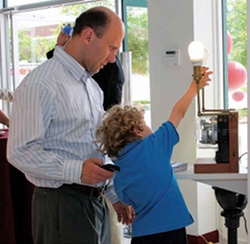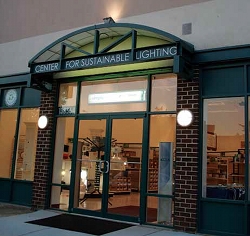by Richard Stukey — For the past several decades, pressure has been mounting on the owners and managers of commercial buildings and other facilities to find energy efficient and environmentally friendly ways to operate buildings—at the same time that financial executives in the C-Suite exert pressure on them to cut operations budgets.
Responding to the calls for environmentally friendly and cost-effective building operations, the first step most building owners and managers made was the replace inefficient HVAC systems and temperature controls. The newer, more environmentally friendly systems saved so much energy that they were able to recoup their investment in a matter of only a few years (or, in some cases, even less).

Not so with lighting. Facilities managers at first resisted making the initial investment because of the high upfront cost of energy efficient lighting systems when compared to expected energy savings. This was particularly true in the case of newly-introduced LED technology that did not seem to promise a quick return on investment, and also had color quality and other technical challenges to overcome before it became more widely accepted.
The relatively high upfront cost of LED’s—estimated by one expert to be $400-500 per fixture, plus labor—deterred many facilities operators from making the switch from traditional incandescent and traditional T12 fluorescent bulbs. Many facility owners and managers dragged their feet for years, waiting for “the next best thing” —hoping that the high upfront cost of energy efficient lighting systems would come down, and the performance of those systems (including color and efficiency) would go up.
According to many lighting experts, that time has arrived. Technological advancements have led to lower prices for fixtures and bulbs, and facilities managers are taking a much closer look at lighting systems—and they’re “seeing the light” when it comes to cost savings and conservation. Instead of only looking at energy savings, they are also factoring in the much lower cost of maintaining the new lighting systems compared to their previously installed systems.
“I have clients who have installed LED lighting systems two years ago and have not had to replace a part in two years,” said Jerry Biron, senior sales engineer at City Electric in San Leandro, California. “They haven’t had to spend a dime in labor, equipment or material costs since they were installed—and the LED bulbs are expected to last 5-10 years with little or no degradation of light.”
Larry Ross, senior director of maintenance and engineering at Erickson Living, is equally enthusiastic about new, energy efficient lighting systems. “Whether we are renovating an existing facility, or building a new facility, we are choosing conservation options, especially in lighting,” he said. “The energy efficient lamps not only significantly reduce energy consumption—providing an immediate return on investment—but they also provide more natural light that improves safety and security in the resident living units and rooms.”
One drawback to LED systems is that they are comprised of small individual lights, which some lighting experts insist makes them more appropriate for parking lots and similar spaces, rather than for indoor office spaces. In the meantime, other energy efficient lighting options have also proliferated.

“There is a lot of buzz out there right now on LED lighting systems,” wrote Church Palm, senior director, NorthMarq Corporate Solutions, on AFE’s LinkedIn group site. “While LED’s have the potential to be highly efficient and reliable lighting systems, many systems sold today do not live up to their promises. Most lighting experts recommend using LEDs in specialty situations—for signs, accent lighting and parking lots. The majority of lighting for office spaces is currently provided by linear fluorescent systems.”
Some facilities managers complain that LED manufacturers opt for a bluish light that many people in focus groups considered unappealing—but emits more light per kilowatt hour.
Biron, however, says that these complaints are becoming irrelevant as configurations of the small diode lights are designed for specific uses. In addition, he says, the light color and quality from LED systems “have improved tremendously in recent years.”
Enter the LED Retrofit
For those facility owners and managers who are still waiting for “the next best thing” before making a commitment to LEDs or other energy efficient lighting systems, there is even less reason to wait now that a new development in lighting has become more commonplace: the LED retrofit.
C.N. Robinson Lighting Supply, a specialty lighting distributor with several locations in the mid-Atlantic region, is a leader in energy efficient lighting systems and features the latest systems from Philips. “Our company focuses on selling reliable, quality-tested products, like the EnduraLED line of retrofit light bulbs from Philips,” said Rob Mills, president. “We recommend these bulbs to our customers because they contain no mercury, produce instant-on, even light, and use considerably less energy when compared with other incandescent, conventional fluorescent and halogen bulbs.”
Incandescent: The Model T of Lighting

Mills said facilities professionals have to look beyond the price tag and look at the return on investment of these lighting systems. “Many facilities maintenance professionals looked at the price tag of LEDs and got sticker shock,” he said. “But they didn’t look at some of the maintenance factors in replacing bulbs in high ceilings and archways, where the lights are intended to create a dramatic flair. LED’s are designed to last for approximately 45,000 hours, while incandescent bulbs are expected to last only 2,000 hours.”
What does that mean for cost the facilities professional looking to cut costs? “For one thing, it means that there’s a good chance you’ll only have to replace those hard-to-reach bulbs once every 20 years (based on six hours of use each day) versus every year for the incandescent bulb,” said Mills. “It also means, you don’t have to pay the cost of hiring staff (or using on-site staff) and renting special equipment to get to fixtures built into 30-foot ceilings.”
Matthew Wall, marketing manager at Philips Lighting Company, likened using incandescent bulbs to driving a car that is built on Model T technology. “Edison invented the incandescent bulb more than 130 years ago,” he said. “But the technology has remained basically the same. It would be like driving a car designed on Model T technology—except that the Model T became popular long after the invention of incandescent bulb.”
Flourishing Fluorescents
Newer fluorescent lighting fixtures, including T8 bulbs introduced in the mid-1990s—and more recently, the introduction of the even more energy efficient T5 bulb—provide a tremendous boost in energy efficiency over the conventional T12 fluorescent bulbs. The Department of Energy reports that even standard (T12) fluorescent lamps use 25 percent—35 percent of the energy used by incandescent lamps to provide the same amount of illumination (efficacy of 30—110 lumens per watt). They also last about 10 times longer (7,000—24,000 hours).

And while the upfront cost of replacing fluorescent bulbs, ballasts and pin settings is much cheaper than the cost of installing LED systems, any responsible facility manager or building engineer will need to do a careful study of the return on investment: how long it will take to recover those upfront costs based on potential energy and maintenance savings? And how much can you expect to save on rebates offered by many utilities for installing more efficient lighting systems?
Writing on AFE’s LinkedIn group site, Patrick B. —an equipment and facilities maintenance manager in the Dayton, Ohio area—elated his positive experience with energy efficient T8 fluorescent bulb fixtures. “Our 35,000-square-foot production facility with 24-foot ceilings was originally outfitted with High Bay HID fixtures,” he wrote. “We replaced all 90, 400-watt fixtures (operating at 450 watts) with 90, T8 6-bulb fixtures. These new fixtures operate at 220 watts and emit brighter light.” Another advantage to the T8 fixtures: “Our electricity provider is currently issuing a rebate on these fixtures that we applied directly to the capital cost,” he wrote. “The pay back is an amazing: 11 months. All other costs stay relatively the same; new bulb replacement cost of disposal, etc. This is a great way to save on electric costs and provide a well-lighted production area with an emphasis on safety.”
Richard Stukey is senior editor of the Facilities Engineering Journal.